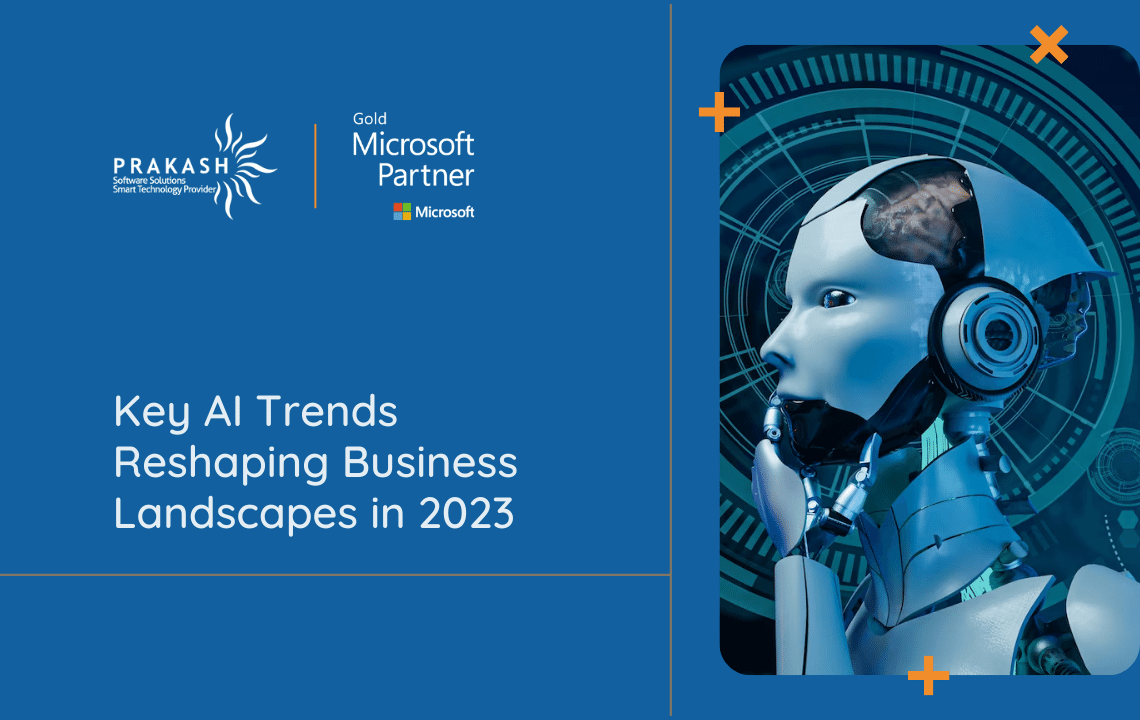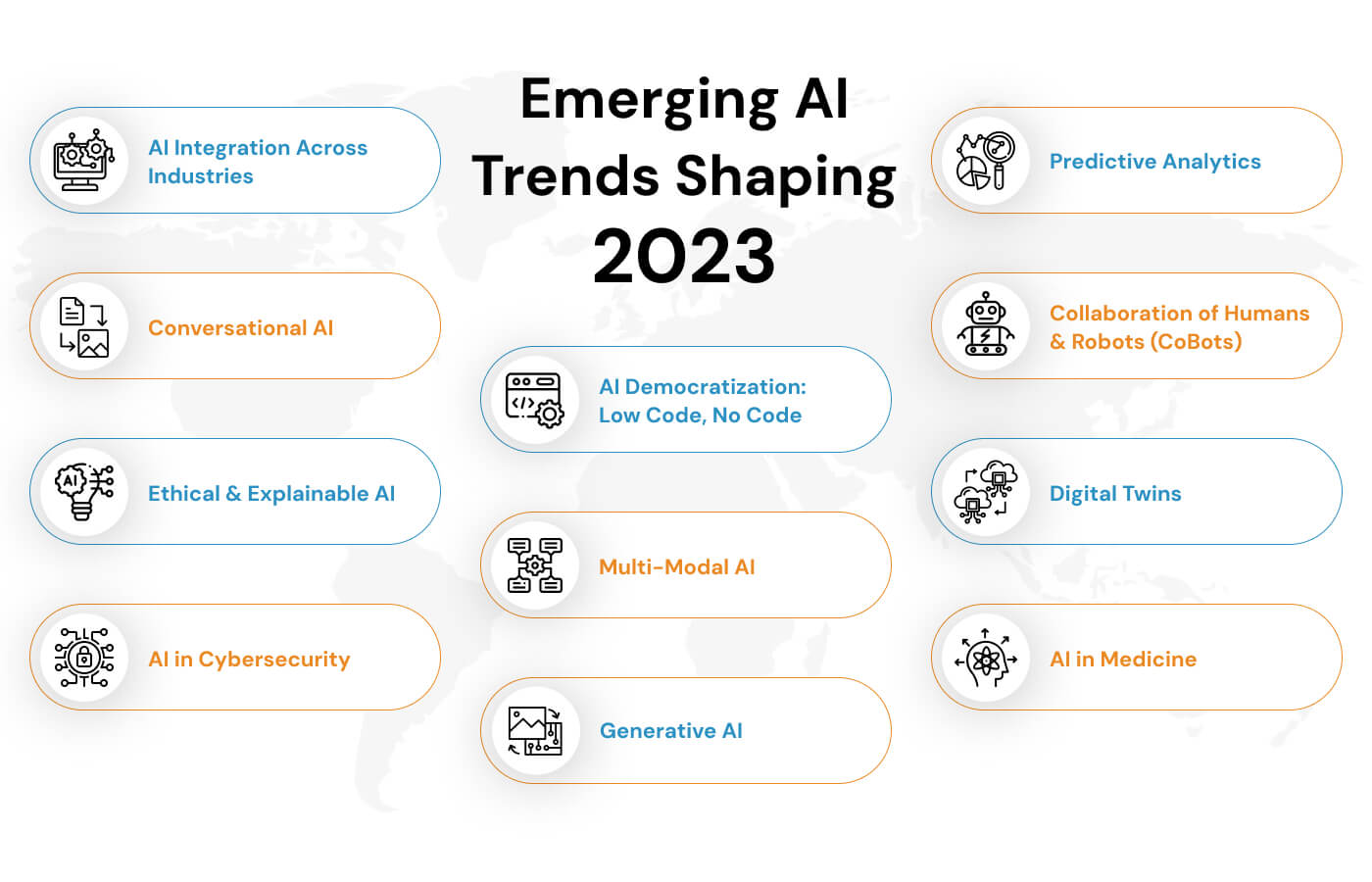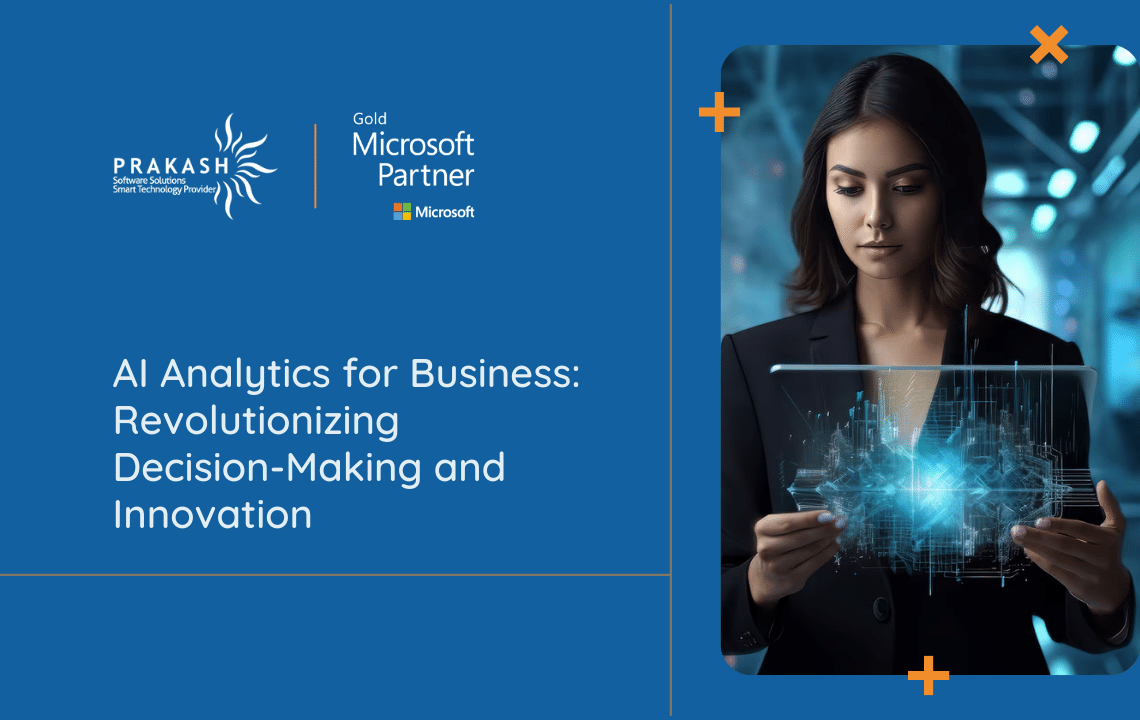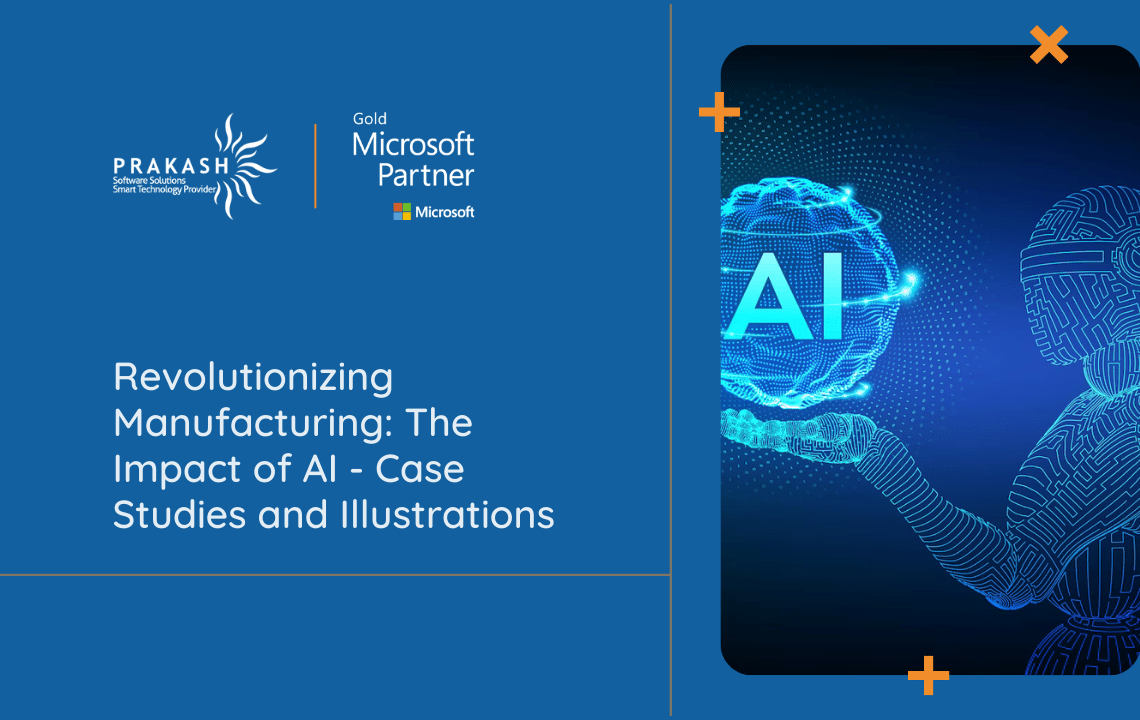
Key AI Trends Reshaping Business Landscapes
AI has emerged as a transformative force, reshaping diverse industries and propelling notable advancements in technology and business processes. In 2023, pivotal AI trends are influencing how businesses operate and engage with their customers. From AI app trends to recent AI developments, the following blog explores the transformative impact of AI on businesses across diverse sectors.
Let’s glance over some of the statistics.
Experience the Influence of the AI Revolution: Illuminating AI Statistics
Embark on a journey to uncover the profound impact of AI technology on businesses, the economy, and daily lives through compelling and enlightening statistics.
- Unprecedented Growth: AI’s Projected CAGR
AI is poised for remarkable growth, projected at an impressive Compound Annual Growth Rate (CAGR) of 37.3% from 2023 to 2030, signaling a significant acceleration in its influence over the coming years.
- Business Optimism: The ChatGPT Advantage
A striking 97% of business owners express confidence in the transformative potential of ChatGPT, a language model harnessing generative AI. They firmly believe that its implementation will yield multiple benefits for their businesses.
- Transforming Customer Relationships: A Consensus
Surpassing 60%, most business owners foresee a positive transformation in customer relationships through AI integration. This reflects a widespread belief in AI’s capacity to enhance and optimize interactions with customers.
- Job Creation Triumph: Addressing Workforce Concerns
AI is not just about automation; it’s a harbinger of job creation. Projections indicate that around 97 million new jobs will be generated, countering apprehensions about workforce displacement and showcasing AI’s potential to contribute significantly to employment.

- A Vision for Increased Productivity: AI’s Role
Looking ahead, 64% of businesses envision AI as a key driver for boosting productivity. This shared vision underscores the confidence in AI’s ability to revolutionize operational efficiency across diverse industries.
In exploring these statistics, one can truly grasp the transformative force of the AI revolution, shaping industries, economies, and the fabric of our daily lives with unprecedented vigor.
Emerging AI Trends Shaping 2023

Recent AI developments stand as a swiftly advancing and dynamically evolving, undeniably making significant strides. The myriad disruptive trends within AI are playing a pivotal role in reshaping the business landscape, and their influence is poised to magnify in the future. Consequently, staying informed about these current AI trends is crucial for entrepreneurs seeking to gain a competitive edge. Let’s delve into the intricate details of each of these transformative AI trends.
AI Integration Across Industries
AI has transcended niche sectors, now integral to diverse industries. From healthcare and finance to manufacturing and retail, businesses widely adopt AI to boost efficiency, productivity, and decision-making processes.
This trend is driven by the realization that AI can provide valuable insights and automation capabilities, leading to better operational outcomes.
Conversational AI
Applications such as Chatbots in Conversational AI are pivotal in automating intricate, repetitive, and rule-based tasks, significantly enhancing customer experiences and boosting overall productivity.
Statista predicts that the chatbot market size will reach approximately $1.25 billion by 2025, showcasing a substantial growth trajectory.
This upward trend is expected to continue as industries explore more advanced applications of conversational AI, demonstrating its potential to handle complex queries efficiently when integrated into various stages of chatbot development.
Predictive Analytics
In the realm of AI trends, businesses increasingly rely on predictive analytics to make well-informed decisions. This burgeoning trend facilitates businesses in optimizing inventory, improving delivery times, cutting operational costs, and ultimately driving sales and revenues.
For instance, predictive analytics in the manufacturing sector allows users to anticipate machine failures, preventing costly breakdowns. With the advent of dropped sensor costs, edge computing, and edge AI, predictive maintenance has become more widely accessible.
AI Democratization: Low Code, No Code
The rise of low-code and no-code AI trends in website and app development empowers businesses to customize intelligent systems through user-friendly drag-and-drop methods and pre-built templates.
This trend not only facilitates the automation of repetitive tasks but also allows businesses to program AI tools efficiently.
According to Business Wire, low-code and no-code devices are not only 70% cheaper but also complete projects faster than traditional methods, fostering a more efficient development environment.
Collaboration of Humans and Robots (CoBots)
Collaborative Robots (CoBots) have emerged as transformative innovations, working alongside human workers to enhance productivity, safety, and efficiency across industries.
With over 3.5 million robots deployed globally, CoBots exemplify the harmonious synergy between human intelligence and robotic precision.
In manufacturing, AI-powered CoBots take over intricate and rule-based tasks, allowing human workers to focus on higher-positioned roles in design, programming, and maintenance.
The application of CoBots in various industries is expected to persist, shaping a future where humans and robots collaborate seamlessly.
Ethical and Explainable AI
As AI applications become increasingly sophisticated, concerns about their ethical implications have risen. The lack of understanding of current AI models, even among researchers and programmers, has led to potential discrimination and misuse.
To address this, the adoption of explainable AI has gained traction. This field focuses on examining patterns in AI models and elucidating how specific decisions are made.
In 2023, overcoming the challenge of the “black box” is a widespread effort, with reputable enterprises implementing explainable AI to enhance transparency and trust by effectively communicating AI outcomes.
Multi-Modal AI
Multi-modal AI represents a paradigm shift in machine learning, incorporating multiple modalities such as speech, images, video, audio, text, and traditional numerical data sets.
This holistic approach creates a more human-like cognitive experience, enhancing natural language understanding, visual perception, and voice recognition for improved user experiences.
Notably, enterprises can leverage multi-modal AI to analyze diverse data streams, exemplified by Google DeepMind’s Gato, a multi-modal AI system proficient in language, visual, and robotic tasks.
Digital Twins
The emergence of Digital Twins involves creating digital replicas of physical objects or processes in the real world, gaining popularity in Industry 4.0 and IoT contexts.
Businesses can monitor, analyze, and optimize real-time performance by using virtual replicas of physical assets. The applications of Digital Twins are vast, ranging from ESG modeling to drug design, smart cities, and beyond. NVIDIA, a leading GPU manufacturer, utilizes digital twin technology in collaboration with Siemens, creating an industrial metaverse.
AI in Cybersecurity
With the increasing sophistication of cyber threats, AI is playing a crucial role in enhancing cybersecurity measures.
AI algorithms can analyze vast amounts of data to identify patterns indicative of potential cyber threats, enabling organizations to proactively defend against attacks.
The integration of AI in cybersecurity is a trend that is rapidly evolving in 2023 to address the dynamic nature of cyber threats.
AI in Medicine
Artificial intelligence (AI) integration is transforming the medical field, sparking a healthcare revolution. This shift heralds an era of precision medicine and fundamentally changes how healthcare services are administered.
AI-driven electronic health records play a pivotal role in facilitating targeted diagnostics, fostering the development of patient-specific drugs, and devising tailored treatment plans.
Notably, this technological advancement holds the promise of mitigating patient harm resulting from negligence or oversights in hospital settings.
AI is playing a crucial role in the expansion of telehealth services, leveraging its capabilities to enable remote physical examinations through smartphone solutions and wearable devices.
Moreover, AI is contributing to the transformation of clinical trials, allowing them to be conducted remotely and sparing participants the need to travel to physical trial sites.
The deployment of AI technology, equipped with emotion recognition and generation capabilities, is making significant strides in enhancing the care provided to individuals dealing with conditions such as autism, depression, and degenerative diseases.
Generative AI
Generative AI, a subset within the realm of machine learning, empowers businesses to develop algorithms and tools for producing fresh data, content, and 3D/2D images based on an existing dataset.
This facet of artificial intelligence leverages the potential of deep learning to discern patterns from diverse data types such as programming languages, audio, video, images, and text.
Conclusion
In conclusion, the AI landscape in 2023 is marked by transformative trends that are reshaping the way businesses operate across industries.
AI’s impact is widespread, spanning diverse sectors through integration, AI-powered apps, and recent NLP advancements. As businesses embrace AI trends, it is essential to prioritize ethical considerations and responsible AI development.
This will ensure the long-term success and sustainability of AI applications in the ever-evolving digital landscape.
Frequently Asked Questions
Current AI trends encompass AutoML, Multi-modal AI, Explainable AI, Computer Vision, Neural Networks, Digital Twins, and more. These trends foster sustainable business growth, transforming how we work, learn, and engage with technology.
Future AI trends will revolutionize businesses, offering countless possibilities—from AI-powered chips for complimentary travel tokens to cashier-less stores. The scope is vast, with AI expected to bring about transformative changes within a few years.
Recent advancements in NLP improve machines' understanding and response to human language, driving the sophistication of virtual assistants and language translation tools.
AI in cybersecurity analyzes vast data to identify patterns indicative of potential threats, proactively defending organizations against cyber-attacks.
The adoption of ethical AI practices and responsible AI development is crucial to avoid biases and unintended consequences, fostering trust and accountability.



